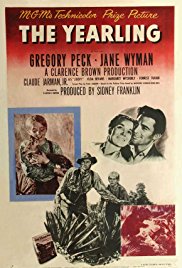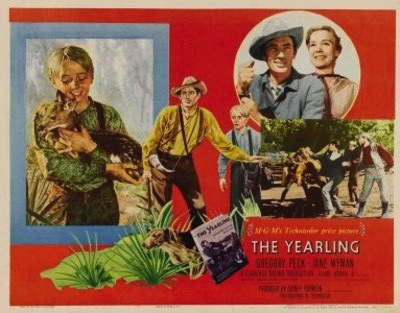Jody is a young boy living on an isolated homestead in the Florida swamps after the Civil War. He adopts an orphaned fawn and raises it as a pet. The movie recounts the boy’s experiences as he grows to manhood and tries to keep the fawn as it matures into an adult deer. The film is adapted from the novel by Marjorie Kinnan Rawlings.
Selected Awards: 1946 Academy Awards: Best Color Cinematography, Best Interior Decoration, Outstanding Child Actor (Jarman); 1947 Golden Globe Awards: Best Actor-Drama (Peck); 1946 Academy Awards Nominations: Best Picture; Best Actor (Peck), Best Actress (Wyman), Best Director (Brown), Best Film Editing.
Featured Actors: Gregory Peck, Jane Wyman, Claude Jarman Jr., Chill Wills, Henry Travors.
Director: Clarence Brown.
“The Yearling” introduces children to the difficult frontier life in rural Florida during the second half of the 19th century. The father is a role model for a loving family man and a hard working pioneer. The mother’s somewhat difficult relationship with her son gives depth to the story and shows that adults can have strong fears and emotional problems that interfere with their ability to be good parents.
Good readers, ages 11 and older, should be encouraged to read the novel before seeing the film.
MODERATE: At the end of the movie, Jody is forced to kill his pet deer. It has been mortally wounded by his mother who found it eating the family’s corn seedlings for the third time. If your child is very sensitive or attuned to animals, you may need to comfort him or her at the end of the movie.
Note also that Jody runs away from home and is saved by a friendly boat captain. You may want to discuss with your child the dangers of running away in today’s world. Explain that Jody was fortunate to be rescued by a person who returned him to his family. That was not always the case then and it is not always the case now. Explain how running away subjects children to great risks (go into as much detail as you can without giving the child nightmares).
There is some alcohol use and pipe smoking in the film.
Your child may have been assigned this book by a teacher who also intends to show the film. Be sure you do not interrupt the teacher’s lesson by showing the film before the class assignments are completed. This is a touching story about love for an animal and responsibility to family as well as the resiliency of the spirit of youth. Be prepared to console your child should he or she be justifiably saddened by the death of the deer. Ask and help your child to answer the Quick Discussion Questions.
The most important goal for pioneer families in the Florida swamps was to grow food. Once there was enough food to sustain the family, the goal was to put in a “money crop.” This would permit the purchase of new equipment or the installation of improvements to the farm (such as a well). One or two luxuries (a new dress, a toy) could be purchased with the proceeds of a money crop. In rural Florida in the last half of the 19th century, the money crops were tobacco and cotton. When a pioneer did not have a money crop and he needed a new piece of equipment, such as a gun, he had to trade for it. In the movie, the father trades the dog for a gun.
Child mortality haunted the life of a pioneer. Most children did not live beyond three years because medicine was primitive and doctors far away. There were three graves of children, all under the age of three, in the graveyard of the family portrayed in this film.
Many pioneers were illiterate or read poorly. Telling tales by the fireside at night was a favorite pioneer pastime Tall tales such as Paul Bunyan were created in this way.
Jody has a very thick accent. Some viewers may find this annoying, but Florida “crackers” did have thick accents.
If you ever go to Orlando, take your children to see the Marjorie Kinnan Rawlings State Historic Site.
MALE ROLE MODEL
1. Would you consider the father in this film to be a male role model? Justify your answer.
2. Did the father do the right thing to sell the dog? Suggested Response: No. He told the truth but in a way he knew that he would not be believed.
COMING OF AGE AND RUNNING AWAY
3. Would you run away if you had to kill your favorite pet in order to prevent it from eating your family’s food?
4. What could have happened to Jody when he ran away?
5. Was Jody right to run away?
FATHER/SON; MOTHER/SON
6. Why was the mother afraid to love Jody? What was she afraid of?
7. How would you describe the father’s relationship with his son?
Discussion Questions Relating to Ethical Issues will facilitate the use of this film to teach ethical principles and critical viewing. Additional questions are set out below.
RESPONSIBILITY
(Do what you are supposed to do; Persevere: keep on trying!; Always do your best; Use self-control; Be self-disciplined; Think before you act — consider the consequences; Be accountable for your choices)
1. Did Jody behave responsibly with regard to the yearling?
CARING
(Be kind; Be compassionate and show you care; Express gratitude; Forgive others; Help people in need)
2. What would have happened to this family if they didn’t love each other?
The Yearling by Marjorie Kinnan Rawlings is an excellent book for strong young adolescent readers.



